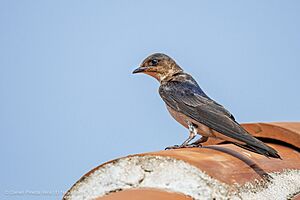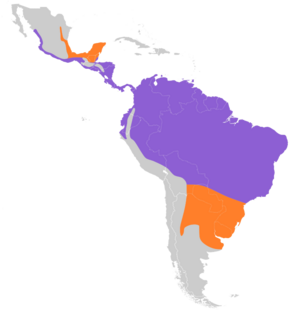Grey-breasted martin facts for kids
Quick facts for kids Grey-breasted martin |
|
|---|---|
 |
|
| In the Sierra Madre de Chiapas moist forests ecoregion | |
| Conservation status | |
| Scientific classification | |
| Genus: |
Progne
|
| Species: |
chalybea
|
 |
|
| Breeding Year-round | |
The grey-breasted martin (Progne chalybea) is a large swallow bird. It lives in Central and South America. These birds are known for their shiny blue-black feathers and grey chests. They are often seen flying high in the sky, catching insects.
Contents
About Its Name
The grey-breasted martin got its scientific name, Hirundo chalybea, in 1789. This name was given by a German scientist named Johann Friedrich Gmelin. The word chalybea comes from Latin and means "steely." This refers to the bird's shiny, steel-like feathers.
Today, the grey-breasted martin is part of a group of nine species. This group is called Progne.
Different Kinds of Grey-breasted Martins
There are three main types, or subspecies, of the grey-breasted martin:
- P. c. chalybea (Gmelin, 1789) – This type lives from Mexico through Central America down to central Brazil. You can also find it on Trinidad.
- P. c. warneri Phillips, A.R., 1986 – This type is found in western Mexico.
- P. c. macrorhamphus Brooke, 1974 – This type breeds further south in South America. It goes as far as central Argentina.
The southern types of these birds travel north during the southern winter. They can fly as far as Venezuela. The other types also move around locally after they have raised their young.
What Does It Look Like?
The grey-breasted martin is about 16 to 18 centimeters (6 to 7 inches) long. It weighs between 33 and 50 grams (1.2 to 1.8 ounces). It has a tail that looks like a fork and wings that are quite wide.
Adult male birds have glossy blue-black feathers on their backs. Their throat, chest, and sides are grey-brown. The lower part of their belly is white. Female birds are not as shiny as males. Their throat is also a bit paler. Young birds have dull brown feathers on their upper parts.
How It Lives
Reproduction
Grey-breasted martins build their nests in holes. These holes can be in banks, buildings, or old woodpecker holes in trees. They usually lay two to four eggs in their nests. The parents sit on the eggs for about 15 to 16 days. After the eggs hatch, the young birds stay in the nest for another 22 days until they are ready to fly.
What It Eats
Grey-breasted martins like to be in groups. They fly around and catch insects in the air. Their call sounds like a gurgly chew-chew. This sound is similar to the Caribbean martin, which is a close relative. The Caribbean martin is a bit bigger and has more noticeable colors on its belly.


